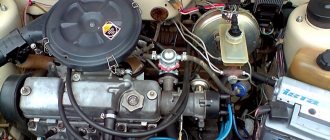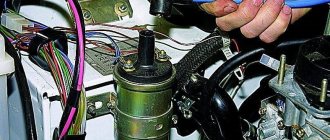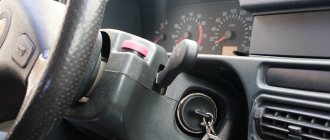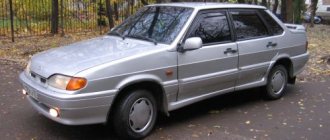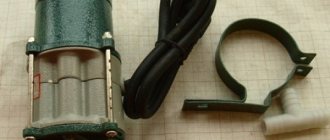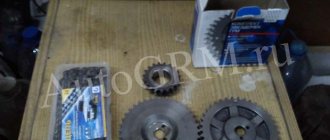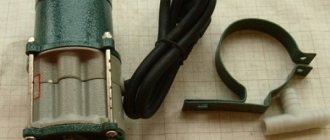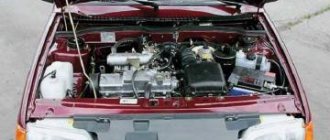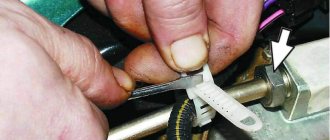Why is the injector difficult to start?
In this case, if on a VAZ 21093 (injector) car there are dips and jerks at the moment of transition from idle, there is a malfunction in the throttle position regulator.
Please note that this is not a sensor, but an actuator. It does not read, but controls the position of the rotor. The water temperature sensor in the engine cooling system often burns out.
Here there is a slight increase in gasoline consumption and with a hot engine it is sometimes difficult to start.
Listen to whether the fuel pump is running when the ignition is turned on. If there is no corresponding sound, then check the fuses on the VAZ 21093 (injector). Specifically, the one that is responsible for supplying power to the fuel pump and its electrical relay.
It would also be a good idea to check the presence of power on all sensors of the accounting system. Check all vehicle wiring for breaks. If our customer remains ok, but the car does not start, then there is mainly a glitch in the software installed in the ECU.
Here you will have to contact 100 for a working version of diagnostics and firmware of the microcontroller.
Muffler
Sometimes an injection car does not want to start due to shedding of the catalyst in the muffler. It serves to reduce harmful emissions and is installed in accordance with current environmental legislation on all cars.
When the catalyst crumbles, the gases cannot escape normally, which means that the car will not move, since the computer will not allow it to start. It is not difficult to check this possibility - unscrew the muffler mount so that the exhaust comes directly from the resonator. If this helps, then change the catalyst.
VAZ 2109 won't start when hot - reasons
Here is a list of reasons why a VAZ 2109 with an injection engine does not start when hot:
- A friend had exactly the same nonsense as you on a V8. You remove the chip from the sensor, the car starts. He drove it like that until he sold it, and when he sold it, it stopped starting at all and there was a new buyer with no problems couldn't start it.
- Perhaps off topic, but I had the same problem in two cars at once! first on 15k (after measuring the compression it turned out that it was the problem. It was: 6-3-9-12...no comments) On the second car 21093, 2002. had the same problem. managed to fix it today! I previously changed the fuel pump, filter, module... nothing helped! I checked the compression 12-11-12-11, I didn’t get around to measuring the pressure in the ramp! In the end it turned out to be simple! IT WAS ABOUT THE ELEMENTARY! The ignition marks have been knocked down! in my case, the former owner turned the crankshaft gear over. and the pin was inward! As a result, the damper pulley spun and the crankshaft sensor did not work correctly.
- On the passenger side, under the shelf, there is a small block with three relays and three fuses. These three switches often work on and off. In this regard, their contacts quickly get dirty. Therefore, these relyushki need to be looked after. They need to be removed, disassembled and the contacts cleaned at least once a year (I do this once every six months). In the relay itself, the plate with the switching contact can be easily pulled out. The contacts have the shape of a hemisphere. If the shape of the sphere is damaged, then there is no point in cleaning it; change the relay. If the shape of the sphere is not damaged, clean the contact on the plate, as well as the other contact that sits rigidly in the relay body. In this case, you should never clean it with a file; it is not advisable to clean it even with No. 0 sandpaper. Use any non-smooth or synthetic material. Afterwards, rinse the contacts with alcohol or vodka, dry naturally or with clean meter, and reassemble. If you clean the contacts once, then you don’t have to go through the procedure of stripping the gear every time. It is enough to remove the cover of the relay, put a thin clean cloth moistened with vodka or alcohol on a thin screwdriver and wipe the contacts, then use the same, but dry piece of cloth. And you will never have problems like “it won’t start when hot”! One more thing (I’ve encountered this more than once). This block has three fuses: 30A and two 7.5A. So, it is in this block that a crack appears in the 7.5A fuses in the jumper between the contacts. The crack may or may not be noticeable to the eye, the device will show that the fuse is intact, but under load it may not work! Therefore, in my car, among other things, I have a set of fuses and at least a couple of relays.
- As an option, the wire from the battery to the retractor and from the retractor to the starter has oxidized. When it heats up, the copper bolt of the wire fastening from the retractor lengthens, the good contact disappears (and there is a large current there), when it cools down, the wire is pressed against the nut and the contact improves (a typical glitch if you don’t take care of the machine.) It can be treated by stripping the corresponding terminals of the bolts and nuts.
- The wiring wires to the block or in the block from the ignition switch melted. Check both pads for melted individual wires. Re-crimp the melted ones by stripping them onto new male/female wires. Remove the wires, replace the pads, do not mix anything up. Other wires may not be suitable in location. Or, as an option, the gas filter is clogged. Fuel flows too slowly through the debris in the filter.
Useful tips
If you can’t start a carburetor engine, you should try the following:
- lift the hood and perform a visual inspection of the carburetor;
- Check the secure fastening of all terminals and wiring. After all, sometimes the problem is in a loose terminal, therefore, without checking it, the entire carburetor is subject to repair. Financial costs increase significantly;
- Sometimes the cause of poor starting of the car is overheating of the fuel pump. If it is too hot, it may soon fail, and it is better to purchase and install a new one;
- At the same time, it is necessary to evaluate the performance of oil filters.
Step-by-step repair instructions
By following a certain sequence in your actions, you will eventually be able to determine on your own why the engine does not start or problems arise with it.
| Repair stage | Your actions |
| Turn the ignition key, check the starter | If the key turns and the starter turns, then this is definitely not the reason. Even if the engine doesn't start. A failure of the starter indicates the need to replace it. |
| Check the fuel level in the tank | You should not rely only on the sensor readings. He sometimes cheats. More than once it happened that a car owner went through almost the entire car, rebuilt the carburetor, and in the end it turned out that the fuel had simply run out. It may be funny, but it’s still worth checking for yourself that there is fuel in the gas tank. |
| Make sure there is spark | Remove any of the spark plugs, connect to the high voltage wire and touch ground (engine). You will need a partner to sit behind the wheel and turn the starter. If a spark appears at the tip, everything is fine. Is she not there? Blame the switching unit and replace the switch with a new one. |
| Check for spark on the center wire from the coil | A test method similar to the spark plug is used. If no spark is detected, most likely the coil has failed. Replace element |
| Assess the state of the power system | If it's freezing outside, there may be water in the gasoline, which eventually turns into ice. To check this, open the air valve and press the fuel pump button several times. The sound of gurgling sounds indicates that gasoline is flowing to the carburetor. The absence of rolls will not allow starting the carburetor when cold, since the fuel is partially frozen. You'll have to change the fuel pump here. |
| Fine filter | Look at the condition of the filter. If cracks, damage and other visible defects appear on it, the element will have to be replaced |
| Gasoline supply hoses | Make sure that the hoses supplying gasoline from the pump to the engine are intact. In case of defects, damage, cracks, they must be replaced with new ones. |
| Spark plug | We've already checked the spark. Now unscrew all the spark plugs and inspect them for traces of carbon deposits. If the spark plugs turn out to be black from soot or filled with gasoline, there is no point in cleaning the units with ordinary sandpaper. You will not achieve the desired effect. The only recovery solution is to heat them on a gas stove. If you don't want to try this method, just install a new set of quality spark plugs |
| Distributor high voltage wires | Remove them and check for integrity and absence of damage. If there are any, buy a new set and install it on the car |
| Distributor cover | The presence of chips and scorched contacts inside it indicates wear and loss of functionality. There is only one way out - change devices. It is worth changing the slider at the same time as the lid. |
| Hall Sensor | Quite often the carburetor does not start precisely because of a faulty Hall sensor. It is held on the distributor with two bolts. Unscrew the fasteners, disconnect the wires and replace the old sensor with a new one. Put everything back together, check the carburetor's functionality |
| Location of distributor high voltages | It is not uncommon for inattentive craftsmen or inexperienced craftsmen who repair their car themselves to make mistakes when reassembling the distributor. High voltage wires must have a specific connection. The wire marked on the cover with the number 1 comes from the leftmost (first) cylinder, then clockwise goes cylinder 2, then 4, and only then 3. If you mix up the location, the car will start to shake wildly or you will not be able to start the carburetor at all |
| Timing belt | You can find the timing belt on the left under the casing. Remove it and evaluate the condition of the belt teeth. If they are partially loose or fall off, it is better to replace the belt with a new one. It is also possible that the valves on the 1.3-liter engine were bent. It is strongly not recommended to resolve this issue on your own. |
- If a step-by-step check of each component of the VAZ 2109 car did not allow you to find the answer to why the carburetor cannot start properly, you will have to go to a service station.
- Practice shows that a detailed inspection of the machine’s components and replacement of worn-out, damaged elements immediately returns the carburetor to its previous functionality; it starts without problems both cold and hot.
The problem that worries me:
I have the following problem: I have a VAZ 21093 made in 1997, for the last 3 weeks, it has become very difficult to start it when the engine is hot, not immediately, but after the car has been standing for 10-15 minutes (I haven’t exactly timed it). When cold it starts literally with half a turn, in winter at -30, it also started normally. I have a new carburetor (only 1000-1500 km done), and the other day I went to the carburetor mechanic to have him check everything again (fuel level, etc.) - everything was in order except the choke cable - I already changed it, also the other day I installed new NGK spark plugs (on one of the old ones the insulator was damaged, but nothing was working; when replacing it, it turned out that the spark plugs were screwed in almost by hand - they tried so hard in the service at the time), a new VARTA battery (although in these weeks I I've already hooked him up a little). By very difficult to start, it means that you have to turn the starter for almost a minute to get it to start and press the gas pedal, and you turn and turn until it catches. I asked at one service center, the guys said that this was a feature of the engine and nothing could be done about it, because... in 15 minutes, gasoline vapors form in the carburetor, something like an air cushion, and you have to learn to live with it. I don't believe them, what is your opinion?
Answers from the forums:
- The same crap, only in a milder form. I don’t start up immediately by pressing the gas, but as soon as it starts to grab a little.
- 1. Check the OZ. 2. Check with two people (in the dark with the hood open) the condition of the explosive part for leaks at start-up. 3. Before turning off the throttle. 4. Start hot with gas and without suction.
- An excess of fuel pressure is formed at the inlet to the float chamber. It can form for two reasons:
1) the valve in the fuel pump does not work. 2) there is no circular circulation of fuel along the line along the return line and through the tank. Most likely the return line or the valve on it does not work, or the nozzle on the carburetor is clogged. If there is excess fuel at the inlet, the needle may not withstand the pressure, squeeze out and let fuel into the carburetor, it will flood.In the summer, you will get stuck with steam locks. You need to vent the return line and (or) change the pump. It may also be that the floats are not positioned correctly and get stuck behind the walls of the chambers. It will also overflow. You always need to look at a new carb - now you can’t trust the plant - these are not the times.
- The switch is, of course, an unpredictable thing... Mine recently died. It started when I started it in the morning, warmed it up a little, and just as I was getting ready to drive, the car stalled and would not start again. In the evening, a friend arrived (on a 9-carb), they began to look for the cause, searched for a long time, then they installed my switch for him, it started up, they installed it back, it started up for me, I decided that somewhere there was something wrong. A few days later everything happened again, only I couldn’t leave for work after lunch. In the evening we started with the switch, it turned out to be dead. I installed a new one. Only it didn’t have any effect on the hot start-up, it started just as badly as it started. I’m also thinking about doing this this weekend, blowing out the return line, and experimenting with the pump.
- Same problem. I’m also racking my brains about what could be messing with my brain. The return line is normal. I checked it over the weekend and fixed the jambs. The switch is also 100 normal BOSH no matter what. All thoughts are carb and fuel pump. The point of the campaign is that when idle, gasoline evaporates in a heated carb and the level drops, so you have to oil it so that the level gets back into place and then it starts normally...
- When it is hot, when stopping and if the cart stands for more than 5 minutes, the carb heats up from the engine, the bottom begins to evaporate intensively, clogging everything, and when starting up, over-enrichment occurs. These are the things to do. What you need to do when starting up is to press the gas pedal to the floor and start it, it will start faster than **clean it off. When it starts, give it a good throttle. It is also useful before parking the car for more than 10 minutes. Propagation also helps
How to help the engine work
Sometimes the VAZ 21099 carburetor does not start well. To help a cold engine work, you need to perform the following steps.
- Press the handle of the fuel pump to pump gasoline into the carburetor float chamber.
- Place the gearshift lever in neutral position.
- Pull the choke toward you, closing the throttle valve, and with the ignition on, try to crank the starter. If unsuccessful, repeat the action after some time.
- If the car starts, let it idle, release the throttle and take your foot off the clutch pedal.
- In the cold season, try to turn the crankshaft several times, turn the headlights on and off, pull out the choke handle, squeeze the clutch and turn the starter. In winter, to keep warm and improve engine performance, it is recommended to wrap the radiator grille. When the engine starts, the pressure control and battery charging lights on the operating panel should go out.
The driver starts the car
When the car is warmed up, its engine should start running immediately. Other situations arise when the machine does not. Starting a hot engine should take place with the throttle valve open and the gas pedal depressed to one third of its full travel. As soon as the engine starts, you need to release the accelerator pedal. If the start is unsuccessful, repeating the described steps may lead to difficulty starting the engine and flooding the spark plugs with gasoline. If this does happen, the turned out candles must be dried with air.
Diagnostics
So, to determine the specific reason for the long start-up of an injection-injected internal combustion engine, you should start with a high-quality diagnosis. Usually, they check the compression in the cylinders. Its values must be within 12 atm for this to be considered normal. In this case, there should be no deviations between these indicators in each of the cylinders (maximum - 1 atm).
Then the spark plugs must be replaced. This will have an effect on the engine and it will now start much faster. However, if everything is not in order with the motor, then the normal starting time will last only 1-2 days.
Therefore, high-voltage wires should also be diagnosed. Diagnostics will make it possible to find out whether the cables have a breakdown, which is clearly visible by the spark coming out at night. This is done as follows: the car starts in the dark, at the same time you need to monitor which wire sparks.
The ignition coil also needs to be checked. Many experienced drivers do this: they install a known good and new module instead of the original one, then check the engine starting for several days. If everything is normal, the start-up does not take long - it means that the whole problem was in the bobbin (ignition coil).
If there are no changes, the test continues. This time you should test all filters, including the air filter. Next - check and replace all sensors and regulators
Pay special attention to the air flow sensor
The next stage: testing various connections, checking the wiring for good contact, cleaning the masses and flushing the throttle assembly.
If nothing changes again, then it is recommended to check the engine fan relay. It often causes similar problems with starting on a fuel-injected internal combustion engine. You can test the relay if you remove the wire from the temperature controller installed on the thermostat.
The fan should turn on after these steps. However, after measuring the resistance value on a warm internal combustion engine, the system can produce low temperature data, although the temperature inside the engine is clearly more than 90 degrees. Why is there such a difference? It turns out that this may well be a buggy DTOZH, which for some reason was not checked earlier. It must show the real coolant temperature, otherwise chaos will begin in the system, and it is not surprising that the engine takes so long to start.
VAZ2109 Long Cold Start.
#1 callt111
“Only a fool persists in a mistake.”
Users 538 posts
- Orel city
- Gender: Man
#2 GENNA
NP ADACT 4306 messages
- City: KLINTSY
- Gender: Man
Post edited by GENNA: 30 March 2012 — 19:24
#3 buruduk
Users 25 posts
- Orel city
- Gender: Man
#4 callt111
“Only a fool persists in a mistake.”
Users 538 posts
- Orel city
- Gender: Man
Post edited by callt111: 30 March 2012 — 19:51
#5 buruduk
Users 25 posts
- Orel city
- Gender: Man
#6 Lancer
Users 192 posts
- City: Yoshkar-Ola
- Gender: Man
#7 kraton
APC-Users 834 posts
- City: Novomoskovsk
- Gender: Man
Post edited by kraton: 30 March 2012 — 21:01
#8 GENNA
NP ADACT 4306 messages
- City: KLINTSY
- Gender: Man
Exactly where to look for voltage sag? It seems like when cranking with the starter, the drawdown goes up to 8 volts, and the voltage drops at 15 kL and 30 kL of the battery seem not to be detected below. When starting up, I noticed a drawdown at the GR of up to 3 volts once, but then everything was fine. After that I checked all the circuits everything is OK. WHAT is this poltergeist?
Post edited by GENNA: 30 March 2012 — 21:13
#9 kraton
APC-Users 834 posts
- City: Novomoskovsk
- Gender: Man
Post edited by kraton: 31 March 2012 — 05:32
#10 antip66
APC-Users 2827 posts
- City: Lugansk
- Gender: Man
when cranking the starter, the drawdown goes up to 8 volts
When starting up, I noticed a drawdown at the GR of up to 3 volts once, but then everything was fine
Anyway, the relay is already in question - I would replace it. Once there was a client on Kalina - the pump sometimes does not turn on, but if it turns on, it works until the ignition is turned off. Well, I figured out the relay in a short time, and then I became interested and took the relay apart. There was a piece of some kind of magnetized crap of irregular shape. It stuck next to the contacts, and if it became flat, there was contact, but while standing, it did not allow the contacts to close. Well, they didn’t seem to mention it yet - the starter may be at fault (short circuits inside, strong interference). To check, try to start it with a pusher.
TS wrote - “but during a long start-up there are no pulses to the ignition module. At the same time, the signal is coming from the Dpkv.”
#11 Evgen
NP ADACT 12650 messages
- City: Ekaterinburg USSR
- Gender: Man
#12 DDD
New users 4 posts
- City: Tselina
- Gender: Man
you take a multitester. (condition - BATTERY IS CHARGED) (the starter is healthy) you measure the voltage on the battery while the starter is cranking, if there is a drop below 9 - throw the battery in the trash, if more than 10 V you measure between the positive of the battery and the engine, also while the starter is running, if below 9 you check the contacts ICE WEIGHTS and Pluses the difference in voltage is no more than half) 0.5 (volts, if more than 1 volt, check the ground contacts. If that doesn’t help, measure the current supply cables.
it takes 10 minutes, 3-4 cranks with the starter so that everything becomes clear, the presence of an assistant is mandatory.
If you have achieved proper power supply on the engine and there is a voltage drop in the ECU, you remove the ECU connector, check the voltage on the current-carrying contacts in the ECU connector, everywhere the difference is no more than half a volt (I mean the difference between the readings on the battery and on other contacts of the system) When you have achieved correct power supply to the internal combustion engine and the ECU system Only after that do you get into electronics.
that is, in the ECU. Good luck . BC 5.1 is more critical to launch when there are jambs in the power supply 9 is already an ambush P.S. This is in case of pop-up 1602
Post edited by DDD: 31 March 2012 — 06:03
Source
If the carburetor starts to stall at idle
This situation often occurs in carburetor VAZ-2109 cars. You can do the following with your own hands:
If you turn to an experienced carburetor for advice, he, based on his practice, will definitely tell you that by carefully inspecting the car’s components and replacing worn and damaged carburetor elements, their previous functionality will return. And then the car will start without problems - whether hot or cold.
There is a special offer on our website. You can get a free consultation with our corporate lawyer by simply submitting your question in the form below.
Source
How to check the fuel - air system of a VAZ 2110
Another reason why the VAZ 2110 will not start may be a faulty supply of the fuel-air mixture to the car’s engine. In the air supply system, malfunctions occur extremely rarely and boil down to either a tightly clogged air filter or a blockage of the air channel by a foreign object. Such malfunctions are unlikely to occur on a well-maintained personal vehicle. But if the car is, for example, a service car or recently purchased, it would be a good idea to make sure that the filter is intact and that there is no rag stuck in the channel after a recent repair.
The engine fuel supply system is controlled by an electronic control unit, which, in turn, regulates the fuel-to-air ratio based on readings from the mass air flow sensor (MAF) and the throttle position sensor. If both of them are faulty, it is not surprising that the VAZ 2110 does not start.
Diagram of the fuel air system of the VAZ 2110
Next, it’s worth checking the condition of the air filter, since this is the easiest thing to do. And, if none of the above steps help, you need to check the pressure in the system created when the fuel pump operates. Connect a pressure gauge to the diagnostic fitting of the fuel rail and measure the pressure. Its low level indicates a clogged pump filter, and its high level indicates a gearbox malfunction.
The normal pressure level directly depends on the type of engine installed in the VAZ 2110 car:
- the limit from 284 to 325 kPa is normal for engines of type 2111, 2112;
- the limit from 364 to 400 kPa is normal for engines type 21114, 21124.
By the way, the serviceability of the fuel pump can also be determined by disconnecting the main gas supply hose to the ramp and pumping gasoline through it into a clean container. A working pump will pump at least 1.5 liters in a minute. fuel.
Also listen to the starter. Does the main electromagnetic relay turn on with a characteristic click and does the electromechanical drive of the unit work at all? Despite the fact that the design of the starter is extremely simple, the electrical contact on it can easily be lost or the gearbox can fail. In the latter case, a characteristic creaking or whistling sound will be heard.
If the starter does not rotate, you should remove it from under the hood of the car. This process will not take much time, just like disassembling the block itself. It is worth checking the serviceability of the electrical part using a multimeter, “ringing” the windings, and disassembling the gearbox. A large amount of lubricant in it in the cold season does not allow the starter to rotate.
Alarm Signals
The starter is the highest-loaded electrical consumer in a car. If, when starting the car, an extraneous sound, noise, or crackling appears, or it becomes clear that there have been changes in the operation of the starter, action must be taken without delay. On a VAZ 2109, problems with the starter can be different, some of them can be fixed with your own hands by reading how to do it or watching a video. Here is a small instruction on faults.
If, however, the starter does not work on the VAZ 2109 and the problem is different, you need to contact a specialist.
Solutions
At first glance there is a lot, but nothing is impossible. What is made by human hands can definitely be repaired, and with the necessary knowledge and skills, this can be done much faster and with better quality. Good repair.
Hello, dear car enthusiasts! All. But, especially car enthusiasts of VAZ models. VAZ starters, despite their reliability, durability and endurance, still fail sooner or later.
The average starter life is usually 5-6 years, which is half the life of the engine. And whether it’s a malfunction of the VAZ 21093, VAZ 2109 or 21099 starter, the problem will still have to be solved by diagnosing, repairing, and possibly even replacing this electrical component.
Since the VAZ starter design differs only slightly, we will take into consideration the situation when the VAZ 2109, 21099 starter does not turn.
After turning the key in the ignition, you may find that:
What to do if the starter does not work? Of course, look for the cause of this phenomenon and try to eliminate it.
VAZ 2109, 21099 starter does not work after one click
Reasons why the VAZ 2109, 21099 starter does not turn,
after a single click, there may be several.
The fork that pushes out the starter bendix may be bent, broken, or otherwise deformed. In this situation, the bendix does not fully fit the flywheel; the cores only partially enter the coil, preventing the contacts from closing.
The teeth on the Bendix sprocket have worn out. Because of this, the solenoid relay cannot transmit voltage to the starter.
Also, the cause of the phenomenon of “one click” of the starter may be either the order of the armature bushings or a short circuit in the winding.
VAZ 2109, 21099 starter does not work after frequent clicks
Repeated clicks are repeated due to the fact that the retracting winding retracts the core, and the holding winding cannot hold it and lets go. This can continue until the battery runs out completely.
VAZ 2109.21099 starter does not work and there is no response to turning the key
The absence of any response from the starter to turning the key in the lock sometimes indicates a short circuit in the windings (if smoke and a burning smell appears from the starter when you try to start).
If the lack of starter response is not accompanied by “special effects” in the form of smoke and a characteristic odor, you should pay attention to the condition of the additional relay and the contacts of the battery terminals. The same reaction of the starter is observed when the ring in the starter gearbox is partially destroyed
The same reaction of the starter is observed when the ring in the starter gearbox is partially destroyed.
If the starter does not respond to turning the key in the lock, you need to take into account that the reason may lie in the key itself. If the check confirms this, it will be enough to just replace the ignition key to fix the problem.
It may also happen that after removing and disassembling the starter, you will not find any damage. Do not rush to replace it with a new one or go to a car service center. Perhaps after you clean the starter, apply new grease and reinstall it, it will come back to life.
After you find and fix the starter malfunction, try not to cause it to break down again in the future, because this lightweight device already has a hard time - the rotation of the massive flywheel and the start of movement of the entire piston group of the engine depend on its serviceability.

